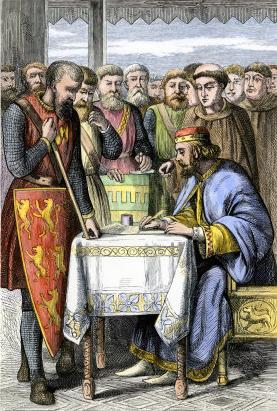
The Magna Carta: 15th June, 1215
On 15th June, 1215, Magna Carta (“The Great Charter of the Liberties”) was agreed between King John (he of Robin Hood fame) and a council of 25 leading barons of England. The charter was agreed at Runnymede on the river Thames. This site was chosen because it lay halfway between the baronial encampment at Windsor and King John’s palace at Westminster. It was considered a safe meeting ground by both factions, as the ground at Runnymede was wet and uneven and therefore unsuitable for a pitched battle.
John had proved himself a thoroughly incompetent, treacherous and immoral ruler. He had lost his hereditary lands in France, imposed repressive taxation on his nobles, abused their wives and daughters and seized landed estates. The basic demands of the rebels were therefore the cessation of arbitrary taxation, an end to false imprisonment (the origin of habeus corpus legislation), open justice and judgement by one’s peers (the origin of trial by Jury).
There is no evidence that either the king or the Council of Barons actually signed any of the various drafts of Magna Carta drawn up between 1215 and 1217, but quite quickly the king was forced to agree to its terms, being desperate to raise money to finance an expedition to regain his ancestral lands in France but unable to proceed without satisfying his powerful critics first.
In order to gain popularity for their cause, the barons had been forced to extend their demands to include “all free men”, thus gaining the support of a large section of the English population. In 1217, a peace treaty was brokered between barons and king by Stephen Langton, the then Archbishop of Canterbury. Magna Carta was agreed in return for a grant of taxation. Years later, In 1297, Edward Ist reissued the charter as part of English Statute Law – he was too short of funds.
The year 1215 marked a turning point in English constitutional history. Over time, all “free born Englishmen” were able to appeal to a body of legal precedents (the origin of English common law) and Parliamentary statutes in defence of their rights, rather than to the arbitrary whim of an absolute monarch. The “rule of law” rather than the exercise of force was legitimised.
In the 17th century, Sir Edward Coke used Magna Carta to challenge Charles Ist and the doctrine of “The Divine Right of Kings”, thus raising Parliamentary rule above that of the monarchy. Magna Carta also influenced the American Constitution of 1789.
Today the charter is of little practical importance; its specific demands have long since been incorporated into 19th and 20th century legislation. But it remains the cornerstone of the concepts of liberty and rule of law common to English, American and European systems.